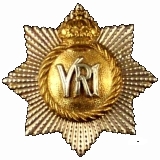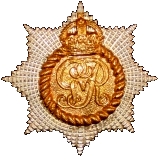
The Royal Canadian Regiment and
The First World War - 1914-1919
Battle Bars and The RCR
By: Captain Michael M. O'Leary
The RCR Battle Bar Ledger (pdf)
Battle Bars proposed for France & Flanders:
THE RETREAT FROM MONS
THE MARNE
THE AISNE
MESSINES 1914
LA BASSEE
YPRES, 1914
NEUVE CHAPELLE
YPRES, 1915
FESTUBERT
LOOS
THE SOMME
FRICOURT
BAZENTIN
DELVILLE WOOD
POZIERES
GUILLEMONT
COURCELLETTE-FLERS
THIEPVAL-COMBLES
BEAUMONT-HAMEL
BAPAUME-PERONNE, 1917
VIMY RIDGE
THE SCARPE. 1917
BULLECOURT
MESSINES, 1917
YPRES, 1917
CAMBRAI
DEFENCE OF ARRAS
DEFENCE OF AMIENS
DEFENCE OF HAZEBROUCK
AISNE, 1918
MARNE, 1918
AMIENS
FLANDERS, 1918
BAPAUME-PERONNE, 1918
THE SCARPE, 1918
HAVRINCOURT
HINDENBURG LINE
BECELAERE
LE CATEAU, 1918
THE SELLE
THE SAMBRE
At the end of the First World War, the Allied Governments were left with the responsibility to mint, name and issue medals to millions of soldiers. For Canada this medal issue would be:
- 71,150 1914-15 Stars (out of over 2.3 million issued to Commonwealth soldiers)
- 427,993 British War Medals (out of 6.5 million)
- 351,289 Victory Medals (out of over 5.7 million)
In 1920 an Imperial Committee on Army Matters dealt with the proposal for battle clasps (bars) for the British War Medal. This proposal would follow the tradition of awarding bars to medals issued to British Empire soldiers and sailors since the Naval General Service Medal (1793-1840), for which 232 different clasps were sanctioned. In Canadian experience, clasps were well-known on the medals for the Fenian Raids, the Northwest Rebellion, and for the South African War.
79 different clasps were recommended for the Army covering all theatres of war: "France and Belgium, Italy, Gallipoli, Mesopotamia, Egypt and Palestine, Macedonia, German East Africa, German South-West Africa, Cameroons, Togoland, Aden, Persia, the Indian Frontier, the Islands of the Pacific." No recommendations were made by the Committee at the time regarding Russia. (68 clasps were recommended for naval forces.)
For the Canadian Expeditionary Force, a list of the proposed Army clasps for France and Belgium survives in the Library and Archives Canada. This list details 41 individual clasps, and also provides some remarks on which would be mutually exclusive. In 1920, the Imperial Committee on Army Matters defined this particular aspect with the following remarks:
"An "area clasp" should be given to those who performed essential duties in a theatre of war, without actually being engaged in active operations, and to those who have served in fighting units, but are ineligible for the battle clasp. No individual who receives a battle clasp for any theatre of war may receive the area clasp of that theatre of war in addition."
In defining the eligibility for clasps for fighting troops and those behind the lines, the Imperial Committee's report further stated that:
"All clasps are the reward of risk or responsibility, the medal being the reward of those in the rear and on lines of communication, but to meet the case of those who did duty in the trenches, but were not eligible for any particular clasps, a year clasp should be given to all who entered certain areas in any year."
Notably, it also limited the number of clasps that could be received by staff officers:
"No staff officer should receive more than 10 clasps; a fighting man should receive all to which he is entitled."
The proposal for battle clasps was revisited in 1923 and a surviving document reveals some of the complexities of the plan up to that time. The 1923 Technical Committee recommended that plans for issue of clasps in annual groups be abandoned, as well as any plan to issue clasps without verification. The Technical Committee recommended that entitlement to clasps be based on regimental achievements, i.e., Battle Honours, combined with confirmation that a soldier was on the strength of the unit at that time.
The Technical Committee considered limiting the issue only to Battle Honours authorized for emblazonment on the regimental colours, and also estimated costs for clasps for all authorized battle honours. In the first case, the total cost was estimated at £490,000 for silver clasps (£320,000 for bronze). In the second case, the total cost was estimated at £780,000 for silver clasps (£440,000 for bronze). For the option of silver bars for all awarded Battle Honours, the projected cost of £780K in 1923 equates to approximately £23.4 million today (or 39 million Canadian dollars).
In that immediate post-War period, the financial costs for battle bars was a critical factor, and it was decided not to proceed with the issue of battle bars. But that was not yet the final word on the proposal.
In 1924, the recommendations of the Technical Committee were revisited and the Imperial Army Council decided to seek His Majesty's approval on a list of authorized clasps and a clasp design. The Army Council also directed that costs would be reevaluated, for silver and nickel clasps, and that eligibility criteria for units which do not receive Battle Honours would be reexamined by the Adjutant-General. By this time, the Royal Navy had received Royal assent, and actually produced limited numbers of their authorized bars, in miniature only.
By July 1924, a new Technical Committee submitted its recommendations following direction to examine whether the cost for battle bars could be reduced to £100,000, that being the limit within which the Treasury would consider advancing the proposal. Suggestions to minimize costs included the employment of women in the distribution offices (to take advantage of lower wages than for men in the same positions) and the use of nickel instead of silver for the clasps.
While the employment of women to reduce cost may have been acceptable to the Army Council, it would appear that making the clasps of nickel was not. A further Technical Committee, reporting in 1925 returned to estimating project cost for silver clasps. The scope of the battle clasp proposal for the Commonwealth at this time is described as follows:
"If the full list of battle honours in the report of the Battles Nomenclature Committee were acted upon, claimants would have 153 action clasps and 16 battle area clasps from which to choose, and the average number of clasps which men would be able to earn would be eight (as compared with an average of five for the list of 94 clasps on which the estimate in the previous report was based). For the 4 million men eligible, this would be an aggregate of 32 million clasps, exclusive of the Indian troops for whom two millions should be added."
"With clasps of silver made to slide on and grip the ribbon instead of being held together in a frame as previously suggested, and with increases to the staffs of A.G.10, and of Record Offices, the total cost of issue would be £517,000 to £573,000."
In an attempt to sustain the proposal in light of unacceptable cost, it was even suggested that an alternative of having clasps purchased at individual expense be considered. A third alternative of individually purchased miniatures was also put forward. None of these options survived and in 1925 the final word on battle clasps was:
"In November, 1925, the Cabinet decided that in the existing financial situation the issue of clasps could not be sanctioned and that it was undesirable owing to the cost of verification, etc., to issue an authority for the purchase of clasps. With regard to private purchases of miniature clasps, the Secretary of State decided that as there were so many battles entitling to clasps, the checking of claims would be a necessity and in view of the Cabinet decision on action could be taken."
While evidence of the deliberations of First World War battle clasps have survived, so too have some documents prepared by Canadian authorities on CEF units. These include the "Battle Bar" sheets prepared on The Royal Canadian Regiment, among other units.
The RCR Battle Bar sheets, although incomplete, offer an excellent tabulation of the Regiment's movement and general activities throughout the Great War. A transcription is provided at the following link:
Battle Bar Documents - The Royal Canadian Regiment (pdf)
Pro Patria
- The O'Leary Collection; Medals of The Royal Canadian Regiment.
- Researching Canadian Soldiers of the First World War
- Researching The Royal Canadian Regiment
- The RCR in the First World War
- Badges of The RCR
- The Senior Subaltern
- The Minute Book (blog)
- Rogue Papers
- Tactical Primers
- The Regimental Library
- Battle Honours
- Perpetuation of the CEF
- A Miscellany
- Quotes
- The Frontenac Times
- Site Map

![]() The RCR in the Great War
The RCR in the Great War
![]() War Diary
War Diary
![]() Battle Honours
Battle Honours
![]() Battle Bars and The RCR
Battle Bars and The RCR
![]() The RCR Battle Bar Ledger (pdf)
The RCR Battle Bar Ledger (pdf)
![]() Honours and Awards
Honours and Awards
![]() Roll of Honour
Roll of Honour
![]() Prisoners of War
Prisoners of War
![]() Cemetery List
Cemetery List
![]() Cemetery Map
Cemetery Map
![]() Courts Martial
Courts Martial
![]() Officers
Officers
![]() RSMs of The RCR (1914-1919)
RSMs of The RCR (1914-1919)
![]() NCOs and Soldiers
NCOs and Soldiers
![]() An Officer's Diary (1914-1918)
An Officer's Diary (1914-1918)
![]() Recollections of a Nonagenerian (R. England) (1916-1919)
Recollections of a Nonagenerian (R. England) (1916-1919)
![]() On to Bermuda (1914-15)
On to Bermuda (1914-15)
![]() England and France 1915-1916 (Hayes; 1931)
England and France 1915-1916 (Hayes; 1931)
![]() Overseas with The Royals (1915)
Overseas with The Royals (1915)
![]() Regimental History Pamphlet (1917)
Regimental History Pamphlet (1917)
![]() Amiens (1918)
Amiens (1918)
![]() Cambrai (1918)
Cambrai (1918)
![]() Monchy-le-Preux (1918)
Monchy-le-Preux (1918)
![]() Under-aged Soldiers in The RCR
Under-aged Soldiers in The RCR
![]() Not All Were Volunteers; The RCR and the Military Service Act
Not All Were Volunteers; The RCR and the Military Service Act
![]() Sentenced to Death by Court Martial
Sentenced to Death by Court Martial
![]() The 7th Trench Mortar Battery
The 7th Trench Mortar Battery
![]() A Regimental Goat
A Regimental Goat
![]() Regiment and Family, Bermuda 1914-15
Regiment and Family, Bermuda 1914-15
![]() "March the Guilty Bastard In"
"March the Guilty Bastard In"
![]() Surrendered as Stowaway
Surrendered as Stowaway
![]() Re-Visiting the Great War Roll of Honour for The RCR
Re-Visiting the Great War Roll of Honour for The RCR
![]() Canadian Corps Trench Standing Orders (1916)
Canadian Corps Trench Standing Orders (1916)

